|
Do you have any photos of Camp White Rock? Would you be willing to let them be used on this web site? Did you serve in the CCC at White Rock Lake? Go through army training here? Are you one of the German POWs who were imprisoned here? Were you a veteran who attended classes at SMU and lived here 1946-'47? Would you be willing to share your memories on this web site? If so, please contact the host at texian1846@yahoo.com
Thanks!
|
|
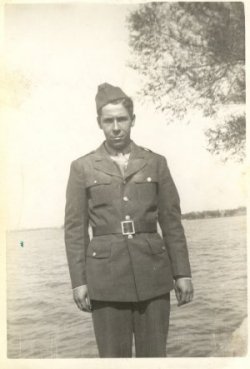
Pvt. Robert C. Irions, a soldier at Camp White Rock, October 1942. Photo courtesy Irions' grandson, Randy Kyle.
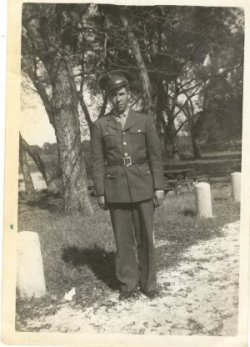
Another photo of Pvt. Irions. Photo courtesy Randy Kyle.
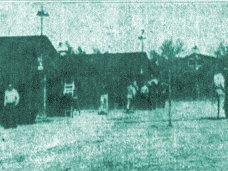
This photo of the POW camp originally appeared in the Daily Dallas Times Herald, edition of December 21, 1944.
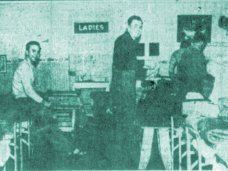
This photo of German POWs at the White Rock Lake camp originally appeared in the Daily Dallas Times Herald, edition of December 21, 1944.
|
|
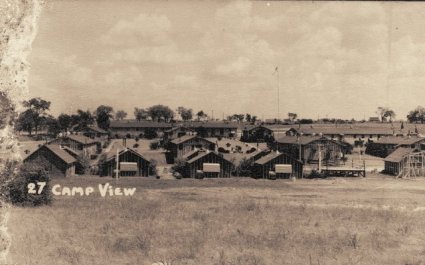
CCC camp photo courtesy The White Rocker.
See also Captioned Photo of CCC Camp Identifying Buildings
On August 8, 1935 the U. S. National Park Service, part of the Department of the Interior, established a 37-acre Civilian Conservation Corps (CCC) camp on the eastern shore of White Rock Lake. The twin baseball diamonds pictured here are located where the barracks and other buildings once stood. Administered by the Army, the CCC was part of President Franklin D. Roosevelt's plan to get America back on its feet during the Great Depression. Officially designated project SP-55, a significant portion of the park's improvements (such as the recreation buildings at Winfrey Point, Sunset Bay and the Big Thicket) were built between 1935 and 1942 by the young men of CCC Company 2896, who lived at the lakeside camp and were paid $30 a month for their labor ($25 of which went home to their families). They also planted trees and constructed bridges, restrooms, picnic pavilions, and the retaining wall of the east side of the lake.
During the seven years the camp was in operation, about 3,000 youths were enrolled.
Not long after World War II began, the CCC program came to an end. Between 1942 and 1943, the old CCC camp was used as by the U.S.Army Air Corps Fifth Ferrying Command as an induction center where many young Dallasites completed their "boot camp"training before shipping out to Europe or the Pacific theater of operations.
After the Army abandoned the camp, 300 German prisoners-of-war, all non-commissioned officers and members of Rommel's "Afrika Korps," arrived in December 1944 to take up residence. The prisoners themselves were put to work constructing the 8-foot tall barbed wire fence that kept them from escaping. In the late afternoon, they were taken by bus to Fair Park where they worked for the Army Quartermaster Dept. in the Centennial Building, repairing tents and other equipment.
To brighten the the interior of their living quarters, some of the Germans painted stenciled pictures of flowers and animals on the barracks walls (which were first painted white). Others tended gardens during their free time. Generally, it appears the men were well-treated and given whatever they wanted, within reason. In October 1945, several months after Germany's surrender the men were repatriated.
In 1951, one of the former P.O.W.s wrote a letter to The Dallas Morning News saying that he had come to like Texas so much during his brief imprisonment at White Rock Lake that he wanted to emigrate and was seeking someone in the area to sponsor him and his family. Whether he was successful or not is unknown.
After the German prisoners went home, the aging CCC barracks were next used by Southern Methodist University as overflow student housing for veterans during the 1946-1947 school year. Afterward, the buildings were gradually sold off or demolished. One structure was moved to a golf course, to be used as a maintence shed. Boards from some of the other buildings were used to construct a basketball court floor in the Foods Pavilion at Fair Park. On a street not far from White Rock Lake, there are three homes that are said to have originally been POW camp buildings. By the early 1950s there were only two structures left standing on the original site and during the early morning hours of Monday, May 28, 1951, one of these was "ripped apart" by a dynamite explosion. Similiar explosions damaged a storage shed at the Mockingbird Golf Driving Range on East Lovers Lane and a flagpole on the SMU campus. Police suspected the explosions were the work of SMU fraternity pranksters. That same year (probably), the remaining buildings were either moved or dismantled, to make way for the baseball diamonds that have occupied the site since 1954.
|
